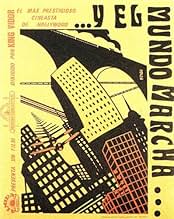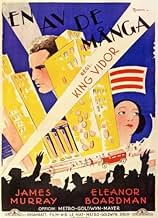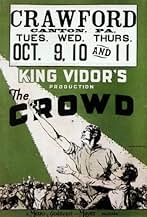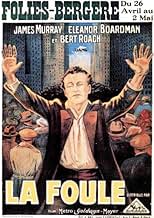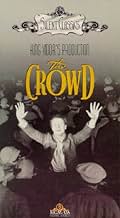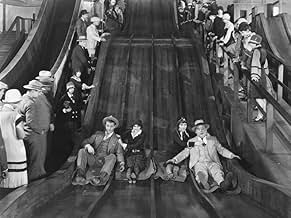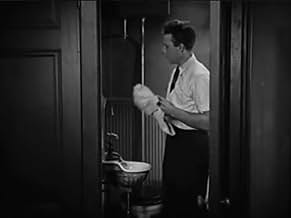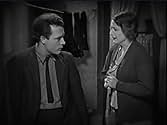AVALIAÇÃO DA IMDb
8,0/10
9,7 mil
SUA AVALIAÇÃO
Na cidade de Nova York na década de 1920, um casal enfrenta as dificuldades de viver na metrópole.Na cidade de Nova York na década de 1920, um casal enfrenta as dificuldades de viver na metrópole.Na cidade de Nova York na década de 1920, um casal enfrenta as dificuldades de viver na metrópole.
- Direção
- Roteiristas
- Artistas
- Indicado a 2 Oscars
- 4 vitórias e 2 indicações no total
John D. Bloss
- Boy on Fence
- (não creditado)
Roy Bloss
- Boy on Fence
- (não creditado)
Sidney Bracey
- John's Supervisor
- (não creditado)
Johnny Downs
- John - Age 12
- (não creditado)
Sally Eilers
- Party Girl at Bert's Place
- (não creditado)
Joseph W. Girard
- Member of Board of Directors
- (não creditado)
Pat Harmon
- Truck Driver
- (não creditado)
Chris-Pin Martin
- Worker in Hallway
- (não creditado)
Claude Payton
- Undetermined Secondary Role
- (não creditado)
Avaliações em destaque
This is easily on the best silent films that I have seen. I got caught up in the story right from the beginning. To a degree, this is a story of the great mass of people that make up "The Crowd." As is pointed out in the beginning, a story of a man who is indispensible to New York (as most think.) He isn't. He thinks he is better than those he works with and is constantly waiting for 'his ship' to come in (which doesn't). In the end he almost loses his wife because of that.
I really enjoyed the scene early in the movie when he and a friend are going to Coney Island with two girls and both stop to watch the girls go up stairs so they can look at their legs. Probably somewhat risque' in 1928.
The film really stands out for the editing. Especially when you remember that this was made in 1928. It is used to also give you excellent views of New York and life in 1928.
I will see this one again and again.
I really enjoyed the scene early in the movie when he and a friend are going to Coney Island with two girls and both stop to watch the girls go up stairs so they can look at their legs. Probably somewhat risque' in 1928.
The film really stands out for the editing. Especially when you remember that this was made in 1928. It is used to also give you excellent views of New York and life in 1928.
I will see this one again and again.
The most remarkable thing about 'The Crowd (1928)' is that is manages to cover so much emotional ground. John (James Murray) is a young man who knew from an early age that he would become somebody special, that he would stand out from the crowd. At age 21, he travels to New York, the towering metropolis introduced via a montage of impressive high- angled shots that resemble Robert Florey's 'Skyscraper Symphony (1929).' John joins the accounting sector of a large insurance firm, and studiously assures himself that he need only work his way up. Years pass. John marries, has two children. It takes him five years to realise that he has become what he swore never to become: a member of The Crowd.
Vidor's message is a double-edged sword. Early in the film, The Crowd is something to be loathed: the camera, in a virtuoso display of technical brilliance, swoops down upon a seemingly-endless room of seated accountants, each man turning pages in mechanical unison. (Billy Wilder later paid homage to this scene in 'The Apartment (1960)'). But when John finally determines to break free from The Crowd, his world falls apart around him – he can't maintain a job, his wife threatens to leave him, he loses his dignity. The film's ending is intriguing in its ambiguity: John is absorbed into the crowds of a laughing theatre audience.
Is it a happy ending, an embracing of conformity? Is it ironic, an acknowledgment of mass delusion? Is Vidor integrating his character into the cinema audience? In 'The Bicycle Thief (1948),' a similar disappearance into the crowd is viewed as tragic, but here I'm not so sure. F.W. Murnau's 'The Last Laugh (1924)' told a similar tale, depicting the bleak prospects of a working-class doorman, played by Emil Jannings. UFA studio thwarted that film by enforcing a ludicrous happy ending that Murnau included only with a snide introductory title card. M-G-M also toyed with a happy ending to 'The Crowd,' but fortunately Vidor's version ultimately won out, a conclusion genuinely unsettling in its uncertainty, and sure to inspire discussion.
Vidor's message is a double-edged sword. Early in the film, The Crowd is something to be loathed: the camera, in a virtuoso display of technical brilliance, swoops down upon a seemingly-endless room of seated accountants, each man turning pages in mechanical unison. (Billy Wilder later paid homage to this scene in 'The Apartment (1960)'). But when John finally determines to break free from The Crowd, his world falls apart around him – he can't maintain a job, his wife threatens to leave him, he loses his dignity. The film's ending is intriguing in its ambiguity: John is absorbed into the crowds of a laughing theatre audience.
Is it a happy ending, an embracing of conformity? Is it ironic, an acknowledgment of mass delusion? Is Vidor integrating his character into the cinema audience? In 'The Bicycle Thief (1948),' a similar disappearance into the crowd is viewed as tragic, but here I'm not so sure. F.W. Murnau's 'The Last Laugh (1924)' told a similar tale, depicting the bleak prospects of a working-class doorman, played by Emil Jannings. UFA studio thwarted that film by enforcing a ludicrous happy ending that Murnau included only with a snide introductory title card. M-G-M also toyed with a happy ending to 'The Crowd,' but fortunately Vidor's version ultimately won out, a conclusion genuinely unsettling in its uncertainty, and sure to inspire discussion.
Skilled technique and a thoughtful approach to the lives of some ordinary characters make "The Crowd" a memorable drama that tells an interesting, if mostly downbeat, story with some worthwhile observations on human relationships. It takes skill and judgment to make a memorable movie out of this type of material, and "The Crowd" is one of numerous quality pictures from the final years of the silent era that deserve to be much better remembered.
James Murray and Eleanor Boardman are completely believable as a typical couple starting out with all kinds of dreams and expectations. As they gain increasing experience in the real world, their reactions to events, especially on Murray's part, are by no means always appealing, but they are always genuine. The characters' flaws are made clear, yet you cannot help wishing for better things for them.
The story is structured carefully, with some interesting parallels between the early scenes and the closing sequences. With only a handful of really dramatic turns, the story reveals many things about the characters that implicitly comment on human nature in general. It does not offer many solutions, but it does provide some things to think about.
The symbolism of "The Crowd" fits well with the story, and it adds another dimension to this very effective drama. The occasional camera views of the office workers and other expansive settings re-emphasize the image in a resourceful and visually striking fashion.
James Murray and Eleanor Boardman are completely believable as a typical couple starting out with all kinds of dreams and expectations. As they gain increasing experience in the real world, their reactions to events, especially on Murray's part, are by no means always appealing, but they are always genuine. The characters' flaws are made clear, yet you cannot help wishing for better things for them.
The story is structured carefully, with some interesting parallels between the early scenes and the closing sequences. With only a handful of really dramatic turns, the story reveals many things about the characters that implicitly comment on human nature in general. It does not offer many solutions, but it does provide some things to think about.
The symbolism of "The Crowd" fits well with the story, and it adds another dimension to this very effective drama. The occasional camera views of the office workers and other expansive settings re-emphasize the image in a resourceful and visually striking fashion.
This wonderful silent movie depicts the individual who gets swallowed up by the uniformity of society yet also represents the yearnings and aspirations for the want of a better life. Our main character is forever waiting for his ship to come in and sadly it never does. King Vidors sweeping shot of the rows and rows of desks and the image of John being a faceless number in the crowd. Despite him thinking that he is better than others and it's only a matter of time before his situation improves. It sadly never does and he loses the respect of his wife. Perhaps if there is a moral to this movie, then it should be that life can be a bitter pill to swallow but we should take pleasure in the small things in life and recognise that we have to accept lifes disappointments which will inevitably occur. Don't let the year that the film was made put you off or it being in black and white. This movie will grab you by the throat and won't let go. A classic!
I recently watched this silent movie and I was amazed by its timelessness.
People work everyday on an eight-hour job and has dreams to make it "BIG". In that way, he could stand out of "The Crowd". Eighty years later and people still go through the same routine. Any working person can symphatize with John Sims.
In my humble opinion, the movie is a precursor of the neo-realist movies produced in Europe during the post-World War II era. The movie, in a way, also prophesied the worse: The Great Depression. John Sims, who symbolizes the common man, found it difficult landing a stable job after he quit his previous one.
A great movie, I hope this one must be watched by the viewers of today.
People work everyday on an eight-hour job and has dreams to make it "BIG". In that way, he could stand out of "The Crowd". Eighty years later and people still go through the same routine. Any working person can symphatize with John Sims.
In my humble opinion, the movie is a precursor of the neo-realist movies produced in Europe during the post-World War II era. The movie, in a way, also prophesied the worse: The Great Depression. John Sims, who symbolizes the common man, found it difficult landing a stable job after he quit his previous one.
A great movie, I hope this one must be watched by the viewers of today.
Você sabia?
- CuriosidadesSeveral years after the film was made, alcoholism had taken its toll on lead actor James Murray, who was reduced to panhandling in the street. Ironically, one of the passers-by he solicited for money turned out to be King Vidor, who offered him a part in the film's semi-sequel, O Pão Nosso (1934). Murray declined the offer, thinking it was only made out of pity. He died in 1936 at the age of 35 in a drowning incident. Vidor was sufficiently compelled to write his life story as an unrealized screenplay, which he called "The Actor".
- Erros de gravaçãoAfter John sprays himself with milk when opening the bottle, his clothes go from covered with milk to clean from one shot to the next.
- Citações
Title Card: The crowd laughs with you always... but it will cry with you for only a day.
- Versões alternativasThere is an Italian edition of this film on DVD, distributed by DNA srl, "LA FOLLA (1928) + LA GRANDE PARATA (1925)" (2 Films on a single DVD), re-edited with the contribution of film historian Riccardo Cusin. This version is also available for streaming on some platforms.
- ConexõesEdited into Tentação de Luxo (1931)
Principais escolhas
Faça login para avaliar e ver a lista de recomendações personalizadas
- How long is The Crowd?Fornecido pela Alexa
Detalhes
- Data de lançamento
- País de origem
- Idioma
- Também conhecido como
- The Crowd
- Locações de filme
- Coney Island, Brooklyn, Nova Iorque, Nova Iorque, EUA(nighttime establishing exterior shots)
- Empresa de produção
- Consulte mais créditos da empresa na IMDbPro
- Tempo de duração
- 1 h 38 min(98 min)
- Cor
- Mixagem de som
- Proporção
- 1.33 : 1
Contribua para esta página
Sugerir uma alteração ou adicionar conteúdo ausente

